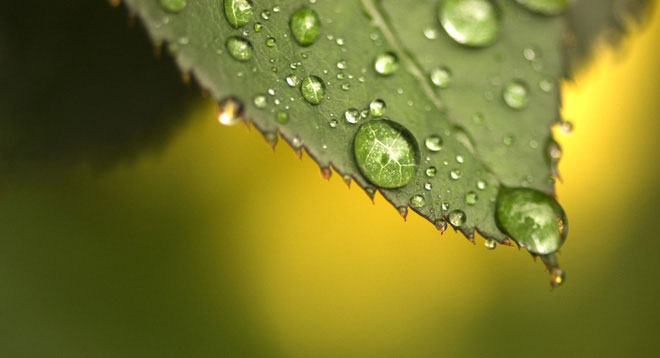Artificial leaves can photosynthesis 'just like', both eliminating CO2 and creating both oxygen and fuel
According to research by the Intergovernmental Panel on Climate Change (IPCC), even if every country stops the instant carbon emissions, we cannot save the current situation; The Earth still faces complicated and unpredictable changes. We need to find a way to handle the amount of CO2 present in the atmosphere.
That's when we look at effective ways to filter CO 2 , a series of new approaches, including a way of getting rid of carbon inspired directly by Mother Nature: a kind of 'artificial leaf'. ' can imitate even the ability to filter CO2 like real leaves. This is the result of research by a multinational research team from the University of Waterloo.
More specifically, this artificial leaf also turns CO 2 into fuel, a double task always. A new scientific report, published in the journal Nature, opens up a new possibility for handling CO2.

This artificial leaf can turn CO 2 into a fuel.
Leading the research team is Yimin A. Wu, working with the Nano Materials Research Center of the Argonne National Laboratory (ANL) and also a professor of engineering at the Waterloo Nano Technology Institute ( WIN). The other two entities participating in the study were California State University and Hong Kong University.
In nature, through photosynthesis, plants convert CO 2 in the atmosphere into glucose and oxygen. Chlorophyll in leaves is the most important ingredient in this particular chemical reaction. Plants get energy from glucose, and oxygen will be a by-product to be released back into the environment.
As explained by Professor Wu, he and his team also applied the same way of treating CO 2 , the photosynthesis of artificial leaves is similar, only different in the output product.
' We call it an artificial leaf because it mimics the photosynthesis process of real leaves. One leaf makes glucose and oxygen, and we make methanol and oxygen , 'he said.

Chemical reactions take place in the laboratory.
In addition to the patience of the team of scientists, trying from 2015 to the present, another key point of this photosynthesis process is the red copper oxide powder. Copper oxide powder comes from a chemical reaction, when glucose, copper acetate, sodium hydroxite and sodium dodecyl are dissolved in water and the mixture is heated to a certain temperature.
After obtaining the powder, scientists will pour it into the water; The powder will act as a catalyst when the mixture receives additional CO 2 from the outside environment, and receives an artificial amount of light from a specialized lighting machine.
Through artificial photosynthesis, the chemical reaction will produce oxygen, while CO2, water and a mixture of catalysts will be converted into methanol. Because the boiling temperature of methanol is lower than water, when the entire mixture is heated, scientists will collect methanol as it evaporates first.
This process of treating CO 2 is similar to a test done by scientists at Cambridge University a while ago; The UK team of scientists also has a device that takes advantage of photosynthesis to treat emissions. By-products will be used in the production of fuels, drugs, plastics and fertilizers.

Test by Cambridge researchers.
There are two reasons why this process of CO2 treatment is remarkable
- First, removing CO 2 from the atmosphere will make it easier for the Earth (and us) to breathe.
- Second, the process produces both fuel. In the immediate future, they may be substitutes for fossil fuels, used in the transition period from combustion engines to electric vehicles.
In the future, scientists will find ways to increase methanol production and commercialize new technology, applying it to fuel-producing industries. And yet, we can apply this technology to filter CO2 in power plants, large but indispensable sources of CO 2 emissions in modern society.
' The potential of the new system is very exciting for me, this discovery can change everything ,' Professor Wu said. ' Climate change is becoming increasingly urgent, and our new way can reduce the amount of CO2 released into the environment, but also create a new alternative fuel .'
- There are artificial leaves that can photosynthesize like real leaves
- Artificial leaves produce energy from polluted water
- Harvard University developed artificial photosynthetic bionic leaves with higher performance than true leaves
- Develop simple, cheap materials for 'artificial photosynthesis'
- Energy from artificial leaves
- Artificial photosynthesis transforms water into hydrogen and oxygen
- Create green fuel by photosynthesis
- There are artificial leaves that can be photosynthesized like true leaves
- Artificial leaves produce gasoline
- Electricity production by artificial leaves
- Convert CO2 into carbon fuel
- Scientists have demonstrated that it is possible to extract water into oxygen and hydrogen in the universe, while also creating breathing air and fuel for running ships.
- Create new electricity from the leaves
- Invent the new generation oxygen generator
 The US company is about to build a supersonic passenger plane of 6,000km / h
The US company is about to build a supersonic passenger plane of 6,000km / h Japan develops avatar robot as in fiction film
Japan develops avatar robot as in fiction film Australia tested the world's first mango picking robot
Australia tested the world's first mango picking robot Finland installs the world's first sand cell system
Finland installs the world's first sand cell system